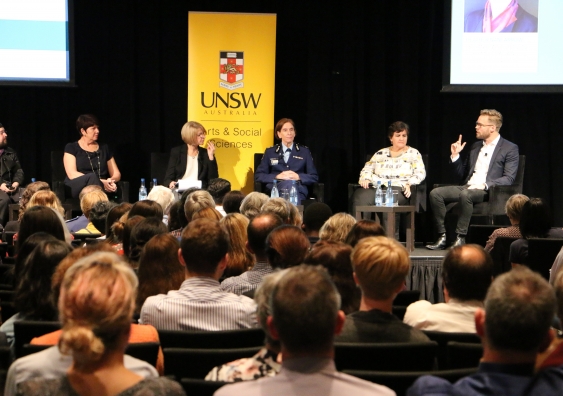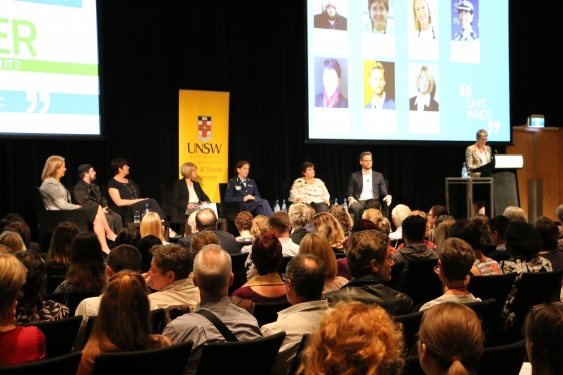Experts discuss gender and violence
Awareness of domestic, family and sexual violence has shattered Australia’s complacency. The challenge now is to better understand its complexity and find solutions.
Awareness of domestic, family and sexual violence has shattered Australia’s complacency. The challenge now is to better understand its complexity and find solutions.

An anecdote about a teenager who helped her mother and grandmother break a decades-long cycle of domestic violence provides a potent example of the value of respectful behaviour lessons in schools.
The 75-year-old woman finally disclosed to a domestic violence worker that she had been living for years with violence. As she endured yet another attack and her 45-year-old daughter, familiar with the pattern, hid under the bed, her 14-year-old granddaughter spoke up: “Nan, it doesn’t have to be like this.”
The story was related by former Sex Discrimination Commissioner Elizabeth Broderick in the latest Says Who? panel discussion hosted by the Faculty of Arts & Social Sciences, “Domestic, Family and Sexual Violence: What’s gender got to do with it?”, which drew more than 400 people to the Sofitel Sydney Wentworth on Thursday night.
The granddaughter knew from her school program that what was happening was wrong. “The one who was the least empowered changed the course of that family’s life because she had learned about it at school,” said Ms Broderick, one of six panellists who were moderated by UNSW's Professor Eileen Baldry. “We need this in our school curriculums across our nation.”
It was one of many powerful moments during the thoughtful and thought-provoking examination of the issues around domestic, family and sexual violence. Other discussion points included the effects of focusing on physical violence, the normalisation of men’s aggression, the importance of businesses recognising violence as a workplace issue, the rise of technology as a tool of coercion and control, the question of male-only shelters, the importance of recognising diversity and the need for structural reform to provide long-lasting solutions.
There was agreement that 2015 Australian of the Year Rosie Batty had helped raise awareness of domestic and family violence, although Associate Professor Jan Breckenridge, Co-Convenor of the UNSW Gendered Violence Research Network, noted that long-term advocacy had also had an impact. But Ms Batty had “allowed us to have a more mature response to how violence affects different groups of people in different ways”, she said.

Professor Susan Dodds, Dean of the Faculty of Arts & Social Sciences, introduces the panel.
Dr Gavi Ansara, board member of the Australian GLBTIQ Multicultural Council, also noted that much of the media focus had been on women as victims of male violence, which meant entire communities were not being included in the debate.
Catherine Burn, Deputy Commissioner, NSW Police Force, said that now there was more awareness, it was important to keep the momentum going.
On the issue of male victims of violence, Associate Professor Breckenridge said violence against men had not always been appropriately addressed. “There’s no doubt there is gender asymmetry but I think we can get hijacked by that debate,” she said. “We should be looking at responses that are helpful to men and to women experiencing domestic and family violence.”
Arguments over statistics meant we were not thinking more creatively about solutions, she said. For example, did “typecasting” women as victims and men as perpetrators hinder research?
Funding and resources were a recurring theme. Deputy Commissioner Burn said more resources were needed to focus on prevention and early intervention. By the time police were involved, it was often too late, she said.
But services had to be careful not to compete with each other. Heather Nancarrow, CEO of Australia’s National Research Organisation for Women’s Safety (ANROWS) and Deputy Chair of the COAG Advisory Panel to reduce violence against women, said resources could be increased through collaboration.
"The essence of the problem of violence against women is an attack on liberty, power and equality and we won’t address it without structural change.”
Responding to a question about the media’s focus on physical violence, Associate Professor Breckenridge said it took attention away from other forms of gender violence such as coercive control, which might manifest itself as a partner controlling finances, a woman being kept out of work or not being allowed to go back to work after pregnancy.
Ms Broderick also noted the rise of more sinister forms of control, such as GPS tracking of women’s cars and the use of apps and other phone tracking technology. She recalled a woman who had decided to leave an abusive relationship only to have her partner track her down because he had put GPS technology into the children’s toys.
Dr Michael Salter, senior lecturer in criminology at Western Sydney University and a member of the Sexualities and Genders Research Network, sounded a note of caution when the panel was asked about the need for male-only refuges. “It’s a mistake to take the framework we have for women’s experience of violence and just use it for men,” he said. “Men are mainly being injured and dying in the street, not at home.”
What of the future? Dr Salter suggested attitudes to male violence needed to change, saying: “We do to an extent normalise and celebrate men’s aggression.”
But while attitudinal change was important, it was not enough. Structural change was crucial to addressing gender and racial equality, Ms Nancarrow said.
“We need to change structures that privilege males and that privilege whiteness. The essence of the problem of violence against women is an attack on liberty, power and equality and we won’t address it without structural change.”